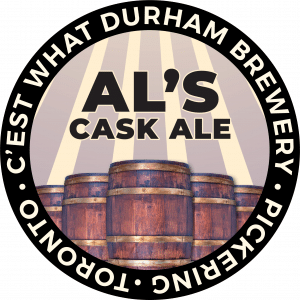 What makes beer like Al’s Cask Ale so special? Read on.
What makes beer like Al’s Cask Ale so special? Read on.
Definition of “Cask Ale”
Cask ale is unfiltered and unpasteurized. Traditionally cask ale is also cask-conditioned, undergoing a secondary fermentation in the cask. This contrasts with “keg beer” which is generally filtered and carbonated. Cask-conditioned beers are also referred to as “real ales”.
Beer Delivery Systems
It took until the 17th century for bottled beer to become commonplace. Up until that time most beer was consumed by pouring it directly out of a cask. Along with advances in science in the later 19th century such as pasteurization and mechanical refrigeration the inevitable march towards tightly controlled, factory produced, mass made and marketed beer had begun. Filtering, pasteurizing, adding controlled amounts of carbon dioxide, and packaging in bottles eliminated the natural variability of cask beer, and the extra care that was needed to properly dispense it. Modern keg beer is identical to bottled beer except that it is pushed to the tap faucet from the keg using a combination of compressed carbon dioxide and nitrogen. The first kegged beer in England was introduced in 1936.
Casks were constructed out of wood until the 1950’s when the use of metal (mainly stainless steel) became widespread. The advantages of metal casks are many: they are airtight which slows the oxidation and spoilage of the beer, stainless steel is also easier to sterilize, is flavour neutral, and is a lot more durable than wood.
Cask Dispensing
There are two ways of dispensing a cask beer: Gravity or pouring the beer directly out of the cask and pulling the beer out of the cask using a piston called a beer engine or hand pump (patented, 1785). The Old English word “draught” meant, “to pull,” like the draught horses that used to deliver beer casks back in the day and later pulling a pint from the cask. Etymologically speaking, keg beer is not draught as it is pushed to the tap faucet.
A gravity dispensed cask beer is set on its side in a rack that is gently inclined towards its tap end. A tap is hammered into the “keystone” in the end and the brew is poured directly from it. If the cask is located remotely in a cellar or refrigerator a hose will be attached to the tap at one end and the beer engine piston in the serving area. This also makes it possible to force the beer through a “sparkler”, the beer world equivalent of a garden hose sprinkler. Forcing the beer through the holes in the sparkler encourages the carbon dioxide to break out of solution and, with the help of proteins in the beer, form a foamy head on top of the brew. There are different grades of sparklers depending on the type of head desired.
Casks and Kegs
As with many traditional systems of measurement definitions of common terms such as barrel vary from country to country. When it comes to casks, British terminology rules. The most common size of cask is a Firkin at 9 imperial gallons or 1⁄4 barrel. The standard keg size follows American traditions and is 1⁄2 barrel or 15 1⁄2 US gallons (12.91 imperial gallons or 58.67 L).
Cask sizes: Pin (4.5 gal.), Firkin (9.0 gal.), Kilderkin (18 gal.), Barrel (36 gal.), Hogshead (54 gal.), Butt (108 gal.), Tun (216 gal.).
Cellaring
Most cask beers are delivered to the pub ready to be prepared for serving. It should be noted that cellar temperature is around 10° C plus or minus a couple of degrees, considerably warmer than the sub-zero taste of “cold”.
Most cask-conditioned beers have “finings” added to the cask to help settle the yeast. Finings are most commonly made from a seaweed called Irish moss, which is processed into carrageenan, or Isinglass, which is derived from the swim bladder of various fish. Finings attract particles floating in the beer and drop forming a somewhat gelatinous cake at the bottom of the cask and leaving the brew clearer.
After the cask has been cellared it has to be rolled to distribute the finings throughout the brew. The cask is then put into its final serving place and is vented. In the traditional rack setup, the cask is vented by knocking a “spile” into the “shive” on the side of cask. When using a spear, the cask is vented through the keystone. The cask is left to set for 24 to 48 hours to allow the excess carbon dioxide to vent and the finings to drop. Once the beer has dropped “bright” it is ready to be served.
The Trouble With Air
Oxidation is the biggest threat to cask beer. As beer is drawn out of the cask air fills the space that remains. Air has an oxygen content of about 21% its effect on the flavour of beer is rapid and not very pretty. The presence of oxygen also encourages the growth of various non-beneficial bacteria that can lead to off-flavours. Heat speeds up both detrimental processes. For this reason, you have about three days to consume a refrigerated cask ale and as little as a day for one stored at room temperature.
However, science can help even the most natural of products. To the rescue is the cask “breather” a device that will allow an inert gas to enter the cask instead of air. The inert gas of choice is nitrogen, which is about 78% of the air we breathe but does not interfere with the chemistry of the beer. The use of a breather should not be confused with kegged beer that is pushed in the beer lines under pressure. The cask breather does not pressurize the keg or introduce carbon dioxide into the beer.
Liquid Heaven
The lower carbonation, and warmer serving temperature, although not suitable for all beer styles, yields a more aromatic and flavourful brew that truly “tastes better and is less filling”. While many modern craft brews have their own merits when kegged or bottled there are no shortcuts that reproduce the undeniable charm of the cask-dispensed beer.


